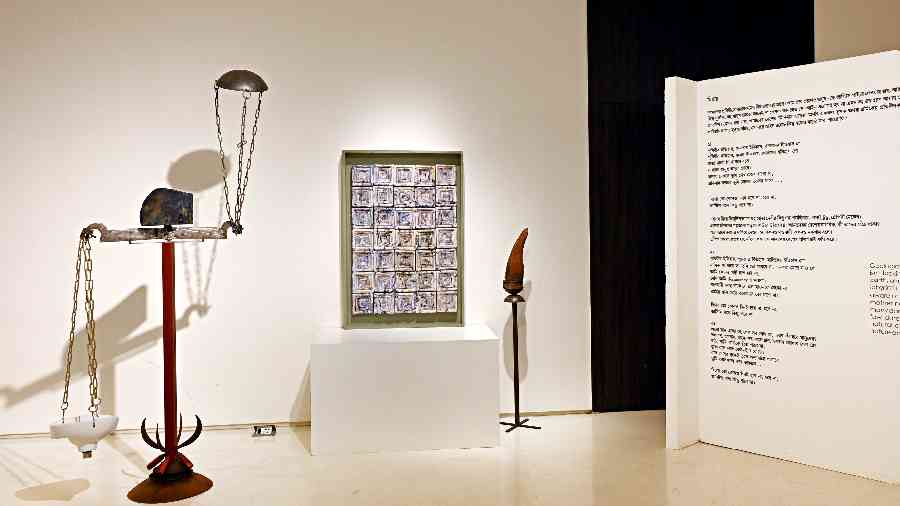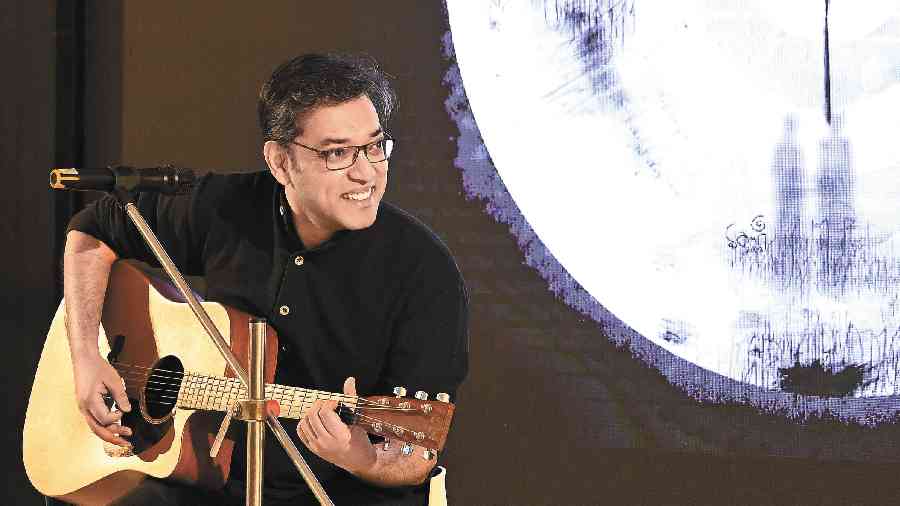On April 1 and 2 at Kolkata Centre for Creativity, singer-songwriter, composer and music director Anupam Roy took his fans on an unforgettable trip with the launch of his album Adrishyo Nagordolar Trip. He dropped a few songs from his eight-track album with a live singing session and collaborated with 10 artists, established as well as budding, who added a new dimension to his deeply personal songs. We caught up with the National Award-winning musician who shared with us the idea behind the unique collaboration. Excerpts:
The fact that you got artists to interpret your songs in different mediums tells us that the album must have been very special to you. Tell us more about it.
I am doing an album after a long time. I have been working for different music labels and films and I strongly felt that I needed to do something for myself. The album is very close to my heart. Adrishyo Nagordolar Trip is an album about illusion; illusion as a part of our existence. I always kept on thinking about life and the eternal question of whether there is a meaning to it. I tried to accumulate songs which I have written over the past 10-12 years which dealt with similar themes. So all eight songs deal with the concept of illusion. For instance, there's a song called Bichaar which is about the judiciary system. We feel that there is someone taking care of justice in this world but actually, I believe, there is no justice in this world. Similarly, I have another song which talks about holding on to a memory and living in a state of denial; that’s another illusion. These songs are quite serious in nature.
Tell us about the idea behind getting creative minds on board to add vivid and thoughtful visuals to the songs.
When I started working on this album I asked my friend Samit Roy, who is the main artist for this album, who designed the artwork for the album’s poster. He gave me eight artworks and I fell in love with all of them. The idea germinated here and I bounced the idea that what if we get artists to interpret the songs in their own ways and then exhibit them during the launch? Thanks to KCC for giving us this place to use as we desired. I feel this place has an amazing vibe to it and it adds to the exhibition.
Were you in touch with the artists while they were working on the songs?
I did not handhold any of the artists because they are artists in their own domain and quite respected and talented as well. I did not interfere at all and let them follow their creative instincts rather than being influenced by my interpretation of the songs. Some of the artists really impressed me and even surprised me with their idea and execution. I loved Sunetra Lahiri’s stitching work on depicting the Kanchenjunga. Again, I found the idea of Souvik Das’s illusive justice quite impressive. I can go on.
The songs are deeply personal. Tell us about the inspiration behind them.
The inspirations have been many. The song Kemon Achho Annie Hall is inspired by a Woody Allen movie. I have been inspired by Maheshweta Devi’s writings and even Tarashankar Banerjee’s novel and Satyajit Ray’s film Jalsaghar.
You have a keen interest in fine arts. Do you practice any other form of art other than creating music?
No, and that’s a big regret. I am an artist with words and music. Ami gaan chara aar kichhu banate pari naa.
What’s next after this?
This is taking so much of my time and it’s getting so exhausting that I am not getting time to think of any other thing. However, the album brought me a big relief.
Ten artists reinterpret Anupam Roy's songs through photography, art installations and painting

A glimpse of Souvik Das’s artwork on display at KCC
Anupam Roy’s Adrishyo Nagordolar Trip brought music and arts together on one platform, each adding to the other and taking it beyond its confines. Ten artists interpreted Roy’s songs like Kemon achho Annie Hall?, Awbawsh, Modhyobitto trap, Guhamanobir gaan, Tomar awshukh and others, in their own creative ways through the medium of installation art, photography, painting, ceramics and more. The three-day exhibition curated by Kounteya Sinha and Oeindrila Roy Kapur started on March 31 at Kolkata Centre for Creativity.
The participating artists included Samit Roy, for whom Adrishyo Nagordolar Trip was a “collage of some tattered moments of gloomy dusty society, which gradually creates some illusions of images in my mind”. With graphic arts, he created that illusion of images with an unseen Ferris wheel with vague, quivering shapes of the shadow-men shuffling and vanishing.
Award-winning artist Sunetra Lahiri picked up Roy’s Kanchenjunga and created a tapestry on silk with the mountain as a metaphor and the man in a dream-like state encountering people and disconnected situations. Rana Pandey and Nilayan Chatterjee’s set of photographs gave Roy’s Tomar Awshukh a new meaning by reimagining the musician’s song of separation and collaborating with Rini Seal, a cancer survivor. Their exhibit, The Ultimate Separation, explores the profound impact of cancer and illustrates how the fatal disease has created corpses — not of those gone but of those who were left behind with a lifetime of memories.

Souvik Das used geological caves as shy beasts, almost invisible, mostly to the human eye that isn’t looking, to India’s judicial laws. The unique weighing scale added more depth to the art. For Pallavi Majumder, Roy’s Jalsaghar was nothing but a fabled space of aspirations, desires, fabricated dreams and flimsy layers of fantasy, woven together with sensitive strings of subconsciousness. Swaarup Swapan describes his artistic representation of Roy’s Kemon achho Annie Hall? as ‘a quick series on the Hollywood classic in a rather simplistic way’. Painted within a span of five hours, it was a small tribute to the millions of Annie Halls and Alvy Singers that make this world so imperfectly beautiful.
Through the medium of ceramic, Jhuma Kundu tried to explore the present scenario of a common man or the swelling middle class — depicting the constant feelings of discomfort, frustration, struggle and disappointment. Occupying almost a central stage, Oiendrila Ray Kapur’s installation showed pages of Tagore’s Gitobitan hanging from a mango tree — torn and rejected. She questions: “What if these words found no takers, then? What if at that time, the commercial was more important than the heart? Wouldn’t we have lost one of the world’s most iconic texts to anonymity?”










